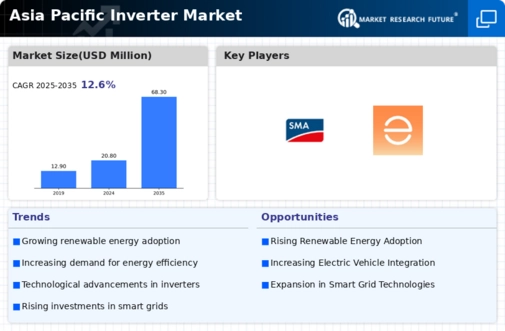The Asia Pacific inverter market is distinguished by its robust development, which is fueled by the region's rapid industrialization, urbanization, and increasing demand for renewable energy solutions. The market is fiercely competitive, with a combination of global giants and regional actors vying for dominance. The market is dominated by major international companies such as Siemens AG, ABB Ltd., and Schneider Electric, which have robust distribution networks and comprehensive product portfolios. To preserve a substantial market share, these organizations capitalize on their technological innovations and global expertise.
Nevertheless, they are confronted with intense competition from regional players, including Delta Electronics and Sungrow Power Supply Co., Ltd., which are notably dominant in China, the largest market in the region. These regional companies frequently benefit from a comprehensive comprehension of local market dynamics and reduced production costs. In the Asia Pacific inverter market, innovation is a critical competitive factor. Companies are emphasizing the development of sophisticated inverters that are more efficient, cost-effective, and more seamlessly integrated with renewable energy sources such as solar and wind power.
The growing complexity of power grids in the region has prompted a significant shift toward smart inverters that provide remote monitoring and grid stabilization capabilities. The solar inverter segment dominates the market as a result of the expanding solar energy sector in countries such as China, India, and Japan. The market is further segmented by product type, including wind inverters, hybrid inverters, and solar inverters. In order to broaden their market presence, organizations are progressively implementing strategies such as mergers and acquisitions, partnerships, and product launches.
Kehua Data Co., Ltd.: Kehua, established in 1988, is a global leader in smart energy solutions. The company focuses on critical power, renewable energy, and data center solutions. Kehua has created a diverse portfolio that includes uninterruptible power supply (UPS), solar inverters, and energy storage systems, with a strong emphasis on innovation and sustainability. Kehua's commitment to R&D is demonstrated by its vast patent portfolio and cutting-edge technology, which ensure reliable and efficient energy management for its clients.
Kehua, headquartered in China, now operates in over 100 countries and territories, supporting a wide range of industries such as finance, telecommunications, and healthcare. Kehua, with a mission of creating a greener, smarter future, continues to lead the global energy market.
Huawei Technologies Co., Ltd.: Huawei, a worldwide technological leader founded in 1987, is well-known for its pioneering contributions to a variety of industries, including telecommunications, IT, and consumer electronics. With a mission to creating a fully connected, intelligent world, Huawei uses sophisticated technology and R&D capabilities to create cutting-edge solutions that accelerate digital transformation and increase global connectivity. The company's diverse array of goods and services ranges from smartphones and tablets to network infrastructure and cloud computing. Huawei is making tremendous advances in solar energy with its smart solar solutions.
The company uses cutting-edge inverters and energy management technology to improve the efficiency and reliability of solar power systems. Huawei's solar solutions are designed to maximize energy generation while lowering costs, thereby facilitating the shift to cleaner and more sustainable energy sources. Huawei intends to stimulate innovation and accelerate global solar energy use by combining AI and big data analytics, thereby contributing to a greener future.












